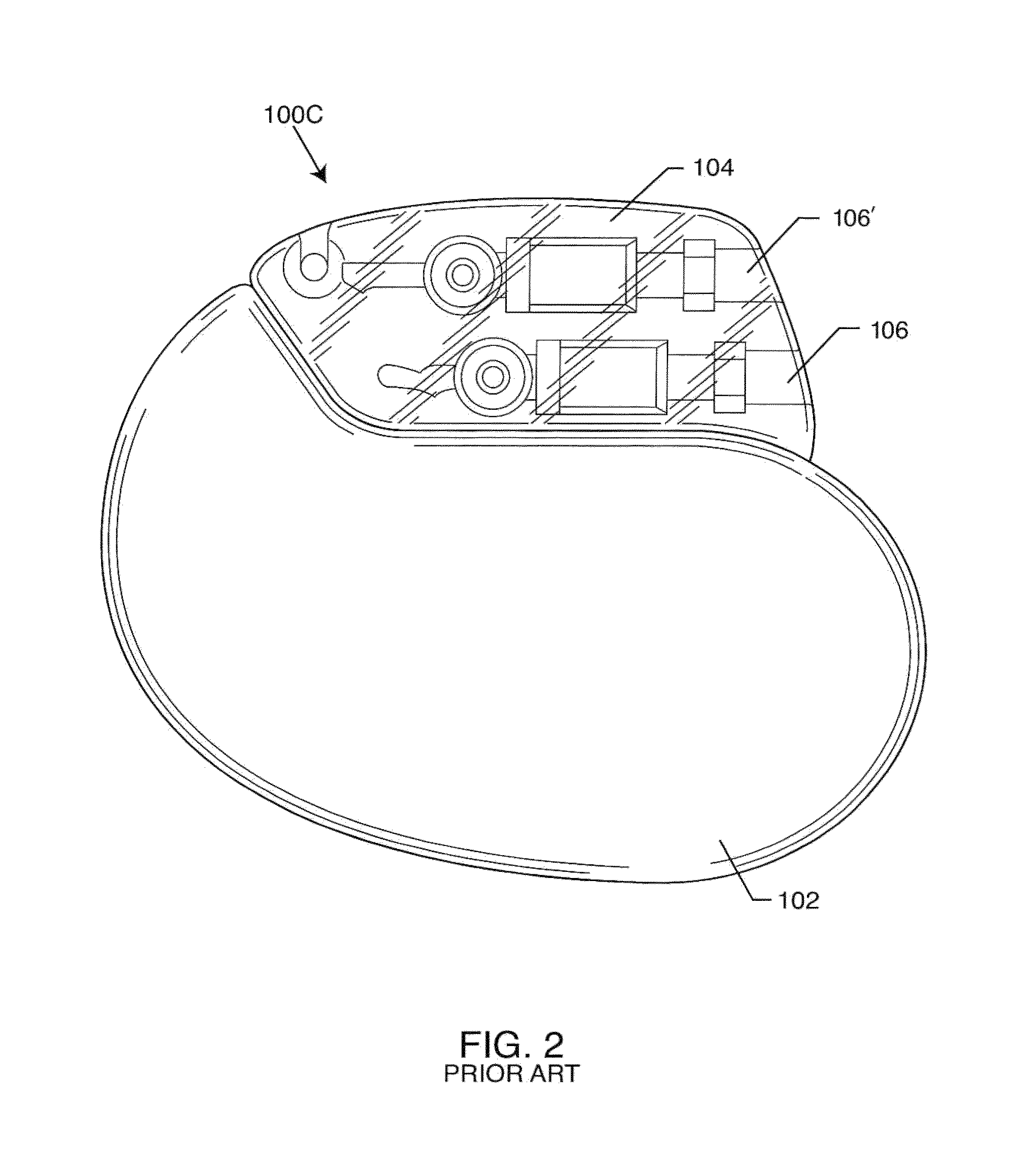Ingress of body fluids into an implantable
medical device is known to be a contributing factor to device malfunction and may contribute to the compromise or failure of electrical circuitry, connections, power sources and other components within an implantable medical device that are necessary for consistent and reliable device therapy delivery to a patient.
Furthermore, ingress of body fluids may compromise an implantable medical device's functionality which may constitute
electrical shorting, element or joint
corrosion,
metal migration or other such harmful consequences affecting consistent and reliable device therapy delivery.
Therefore, when these electromagnetic signals enter within the
interior space of a hermetic implantable medical device, facilitated by the therapy delivery leads, they can negatively
impact the intended function of the medical device and as a result, negatively
impact therapy delivery intended for a patient by that device.
Another particularly problematic condition associated with implanted therapy delivery leads occurs when a patient is in an MRI environment.
In this case, the electrical currents imposed on the implanted therapy delivery leads can cause the leads to heat to the point where
tissue damage is likely.
Moreover, the electrical currents developed in these implanted therapy delivery leads during an MRI procedure can disrupt or damage the sensitive
electronics within the implantable medical device.
Hermetic terminals or
feedthrough assemblies utilizing
ceramic dielectric materials may fail in a brittle manner.
A brittle failure typically occurs when the
ceramic structure is deformed elastically up to an intolerable stress, at which point the
ceramic fails catastrophically.
Even microcracking caused by sufficiently high tensile stress concentrations may result in a
catastrophic failure including loss of hermeticity identified as critical in hermetic terminals for implantable medical devices.
Loss of hermeticity may be a result of design aspects such as a sharp corner which creates a stress riser,
mating materials with a difference of coefficient of thermal expansions (CTE) that generate tensile stresses that ultimately result in loss of hermeticity of the feedthrough or interconnect structure.
In the specific case of hermetic terminal or feedthrough designs, a tensile
stress limit for a given ceramic based hermetic design structure cannot be specified because failure stress in these structures is not a constant.
Further, to provide ensurance for a very low
probability of failure in a critical ceramic based
assembly or subassembly having sustainable hermetic requirements, it is also necessary to design structures embodying a hermetic terminal or feedthrough such that stresses in the final
assembly or subassembly are limited to a smaller level of an average possible failure stress for the entire
assembly or subassembly.
In hermetic terminals and structures comprising hermetic terminals for AIMDs wherein the demand for
biocompatibility exists, this task becomes even more difficult.
Hence, successfully creating a hermetic structure, and one that can sustain its hermeticity in service, is challenging due to the level of residual stresses in the final structure.
Specifically,
thermal expansion mismatch results in stresses acting along the ceramic /
metal interface that tend to separate the ceramic from the
metal and so the bond developed between the ceramic and the metal must be of sufficient strength to withstand these stresses, otherwise adherence failure, that is, loss of hermeticity, will occur.
If the
mating materials are alumina of at least 96% purity and essentially pure platinum paste, then matching CTE is not possible.
Thus, for AIMD's, consistently achieving hermetic terminal structures that are capable of sustaining hermeticity throughout the application's service life has proven challenging.
Since this often is a significant challenge, hermetic terminals are produced by metalizing the alumina and using a
brazing material to form the bond at some other temperature than an intersection of the CTE curves.
As a result, the
filter capacitor and terminal pin assembly prevents entrance of interference signals to the interior of the pacemaker housing, wherein such interference signals could otherwise adversely affect the desired
cardiac pacing or
defibrillation function.
Referring once again to feedthrough
capacitor EMI filter assemblies, although these assemblies as described earlier have performed in a generally satisfactory manner, and notwithstanding that the associated manufacturing and assembly costs are unacceptably high in that the choice of the dielectric material for the
capacitor has significant impacts on cost and final performance of the feedthrough
filter capacitor,
alumina ceramic has not been used in the past as the dielectric material for AIMD feedthrough capacitors.
Direct assembly of the
ceramic capacitor can result in intolerable stress levels to the
capacitor due to the mismatch in thermal coefficients of expansion between the
titanium pacemaker housing (or other metallic structures) and the capacitor dielectric.
Accordingly, the use of dielectric materials with a low dielectric constant and a relatively high modulus of
toughness are desirable yet still difficult to achieve for
capacitance-efficient designs.
An issue with the use of platinum for leadwires is that platinum has become extremely expensive and may be subject to premature fracture under rigorous
processing such as ultrasonic cleaning or application use / misuse, possibly unintentional damaging forces resulting from Twiddler'
s Syndrome.
 Login to View More
Login to View More  Login to View More
Login to View More 


